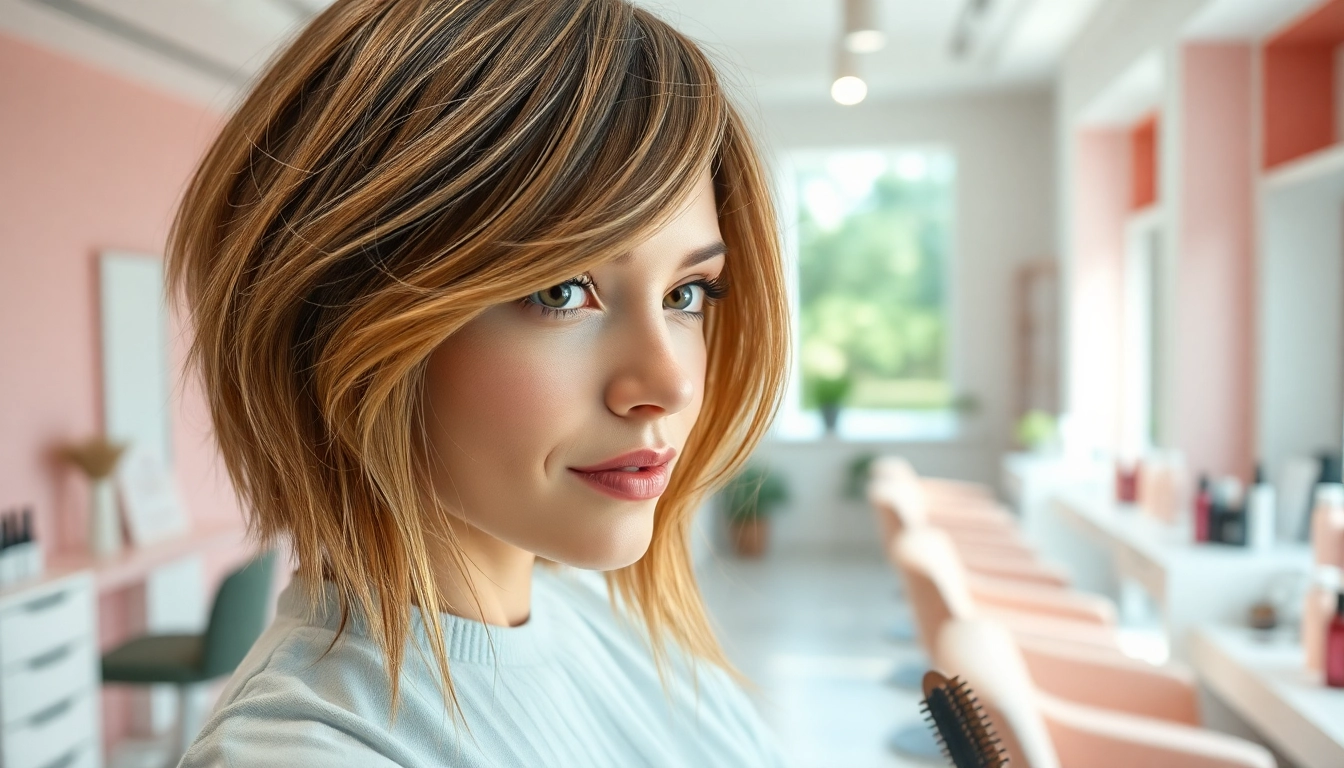Understanding Fine Hair: Characteristics and Challenges
Defining Fine and Thin Hair
Fine hair refers to the diameter of the individual strands. If individual hair strands are thin, they are classified as fine hair. It’s important to note that fine hair does not necessarily indicate a lack of volume, as a person can have fine hair in a dense concentration. On the contrary, thin hair defines the overall density of hair on the scalp; a person can have thick, coarse hair that is thin in terms of density, meaning fewer strands are present.
This distinction is crucial when choosing hairstyles for thin hair. Understanding your hair’s specific characteristics can guide you in selecting styles that complement its unique texture. Fine hair tends to lack elasticity and may appear limp or flat, making certain styling techniques necessary for achieving volume and movement. Thin hair, on the other hand, may necessitate more careful handling to avoid damage.
Common Challenges Faced by Those with Fine Hair
Individuals with fine hair often encounter a range of challenges. Of primary concern is volume; fine hair can struggle to hold styles and often lies flat against the scalp. This can lead to a need for frequent styling and the application of volumizing products. Additionally, fine hair is more prone to damage, split ends, and breakage, primarily because it lacks the density that provides protection against environmental factors and styling practices.
Product buildup is another significant issue for fine-haired individuals. Heavy products can weigh down fine hair, removing any potential volume. As such, selecting the right hair care products becomes essential. Moreover, fine hair can be susceptible to oiliness; individuals may find themselves washing their hair more frequently compared to those with thicker hair types.
How Hair Texture Influences Style Choices
Hair texture plays a pivotal role in determining suitable hairstyles. For fine hair, styles that create the illusion of volume are often preferred. Textured layers can give the appearance of thicker strands, while curl or wave formations can add body and movement. Short hairstyles tend to work well for fine hair as they avoid the weight of longer locks that can pull fine strands down.
Moreover, the level of maintenance required also varies. Styles that necessitate extensive blow-drying or heat styling might not be suitable for those with fine hair due to the predisposition to damage. Understanding the unique attributes of hair texture assists in selecting not just a hairstyle that looks good, but one that is manageable and sustainable.
Trending Hairstyles for Thin Hair
Layered Cuts for Added Volume
Layered cuts are a fantastic option for those with thin hair. By incorporating layers, the hair gains movement and depth, enhancing the aesthetic volume. Shorter layers on top can create lift while longer layers can add dimension, preventing the style from falling flat.
Additionally, different layering techniques, such as point cutting, can further enhance the texture of fine hair. This involves cutting the ends of the hair at a slight angle, creating a softer, more textured appearance that can help in delivering a more voluminous look.
Textured Bob Cuts: A Stylish Option
The textured bob is one of the most sought-after hairstyles for fine hair. This cut falls just above the shoulders and incorporates various lengths to create an effortlessly tousled look. The layers add texture without overwhelming fine strands. A slightly messy finish allows for quick daily styling, making it easy to maintain.
For added interest, consider incorporating waves or curls into the bob. Beachy waves, in particular, can significantly boost volume and provide a more dynamic look, proving that fine hair can still look full of life and movement.
Updos and Styles to Enhance Thin Hair
When it comes to updos, simplicity is key for thin hair. Too much complication can lead to a look that feels overwhelming rather than polished. Styles like a low bun or a soft chignon can enhance the hair’s natural texture without adding unnecessary weight. These styles keep hair off the neck while allowing for a casual yet sophisticated appearance.
Adding elements such as twisted sections or braid accents can create visual interest. Using hair accessories, such as decorative pins or combs, can further accentuate these styles, making fine hair look embellished without requiring excessive bulk.
Haircare Tips for Maintaining Healthy Fine Hair
Best Products for Fine Hair
Finding the right products for fine hair is essential. Lightweight, volumizing formulas are preferred, as they help avoid the heaviness that can weigh down fine strands. Shampoos and conditioners specifically designed for fine hair aim to provide necessary moisture without excess weight. Look for products containing ingredients like panthenol and biotin, which offer hydration while enhancing body and shine.
Additionally, dry shampoos can be highly beneficial, providing instant volume and absorbing excess oil that can contribute to limpness. For styling, mousse and light hold sprays can give volume without creating a heavy feel. Avoid thick creams or oils, as they can be too much for fine hair.
Daily Care Routines for Thin Hair
A consistent hair care routine geared toward fine hair is essential for maintaining its health. Washing hair too frequently can strip essential oils, so aim to wash every other day or even less frequently, using dry shampoo in between. When shampooing, focus on the roots, and apply conditioner primarily to the ends to prevent unnecessary heaviness.
Also, practice gentle towel drying, avoiding harsh rubbing that can cause breakage. Instead, opt for patting hair dry, allowing it to air dry whenever possible. If heat styling is necessary, always apply a heat protectant to minimize damage and maintain the overall health of fine strands.
How to Avoid Damage and Breakage
To mitigate the risk of damage, it’s advisable to limit the use of heat styling tools frequently. When styles do call for heat, use the lowest effective setting and ensure hair has adequate protection. Additionally, regular trims every six to eight weeks can prevent split ends from leading to more extensive damage down the line.
Incorporating a hydrating hair mask or treatment weekly can enhance strength, making hair more resilient against environmental stressors and styling. Choosing the right hair accessories is equally important; opt for soft, snag-free hair ties and clips to minimize breakage during styling.
Expert Styling Techniques for Thin Hair
Using Tools to Create Volume and Texture
Proper tool selection plays a significant role in styling fine hair effectively. A round brush can be invaluable for blow-drying, as it creates lift at the roots and styles hair smooth at the ends. Use a volumizing product before drying to maximize results. A flat iron can be employed for creating subtle waves; by twisting the hair as you glide along the strands, you achieve soft texture without tight curls.
Heat rollers are also a great option for creating volume and can be used on slightly damp hair for added hold. When removed, the hair can be teased lightly at the roots to enhance fullness before finishing off with a light spray for hold.
Professional Tips for Home Styling
Many techniques that professionals use can be easily implemented at home. One key tip is to apply styling products when hair is damp, as this offers better absorption and can help achieve a more controlled style. Consider flipping your head upside down while applying products like mousse to promote natural lift.
Another pro-level tip is to section hair while styling. This enables better access to each part of your hair and makes achieving that perfect lift and volume more manageable. Use clips to keep sections organized and styled methodically, ensuring even application of products.
Styling Techniques to Avoid
While there are multiple effective styling techniques, certain practices can be detrimental to fine hair. For example, over-brushing can lead to breakage. Instead, aim for gentle detangling using a wide-tooth comb, especially when hair is wet and more vulnerable.
Additionally, avoid heavy styling products that can lead to buildup. This excess can weigh down the hair and diminish volume. Always aim for lightweight formulations to maintain a bouncy, full appearance.
Inspiration: Celebrity Hairstyles for Thin Hair
Iconic Looks from the Red Carpet
Celebrity hairstyling often influences looks for women with fine hair. Celebrities like Anne Hathaway and Taylor Swift are known for their stylish cuts that work beautifully for fine hair. Hathaway’s layered bob showcases movement and volume, while Swift often opts for soft waves that enhance fullness.
These iconic styles not only elevate their looks but also serve as inspiration for women with fine hair to experiment with their styles, recognizing that even celebrity looks can be adapted to suit different hair types.
How Celebrities Style Thin Hair
Many celebrities utilize hairpieces or extensions strategically, integrating them into their natural hair to create volume without compromising the integrity of fine hair. For events, they often opt for textures that enhance their natural hair without overwhelming it. This consideration is vital for anyone looking to maintain style while managing fine hair’s specific attributes.
Utilizing professional stylists, many celebrities execute specific techniques, such as the ‘twist and pin’ method, wherein small twists of hair are pinned in varying directions to create a voluminous, textured look. This approach can elevate fine hair to a fresh and chic appearance.
Adapting Celebrity Styles to Everyday Life
Adapting celebrity hairstyles for everyday wear can bring a touch of glamour to daily life for those with fine hair. Draw inspiration from stylized ponytails, textured bobs, or classic updos, adjusting them to suit personal style preferences and occasions. For instance, the highly styled ponytail can be made more casual by deliberately adding some texture or volume without extensive effort.
Remember that the goal is to achieve styles that reflect both personal identity and ease of maintenance; using a simplistic approach to adapt iconic celebrity looks can lead to confidence in wearing styles that highlight fine hair’s potential—revealing that fine hair can indeed display its charm and elegance without considerable fuss.


